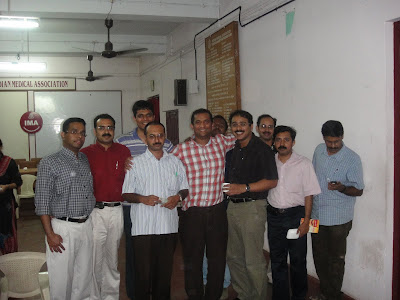so what if JK does a lot of digital prostate examinations, there's an upside to it :)
- Here he goes again....yet another publication...as if we are going to be impressed by this :P
- J Urol. 2008 Mar 14 [Epub ahead of print]
-
Risk Stratification for Biochemical Recurrence in Men With Positive Surgical Margins or Extracapsular Disease After Radical Prostatectomy: Results From the SEARCH Database.
Jayachandran J, Bañez LL, Levy DE, Aronson WJ, Terris MK, Prestijr JC, Amling CL, Kane CJ, Freedland SJ; the SEARCH Database Study Group.Division of Urologic Surgery, Departments of Surgery and Pathology and Duke Prostate Center, Duke University School of Medicine; Urology Section, Veterans Affairs Medical Center Durham, Durham, North Carolina, Urology Section, Veterans Affairs Greater Los Angeles Healthcare System.
PURPOSE: In men with extracapsular disease or positive surgical margins after radical prostatectomy immediate adjuvant therapy decreases the risk of biochemical recurrence at the cost of increased toxicity. We further stratified these men into a low risk group in which watchful waiting after surgery may be preferred and a high risk cohort in which adjuvant therapy may be preferred. MATERIALS AND METHODS: We performed a retrospective analysis of the records of 902 men treated with radical prostatectomy in the Shared Equal-Access Regional Cancer Hospital (SEARCH) database between 1988 and 2007 with positive surgical margins and/or extracapsular disease without seminal vesicle invasion or lymph node metastasis. The significant independent predictors of biochemical recurrence were determined using a multivariate Cox proportional hazards model. Based on the recurrence risk generated from the multivariate Cox proportional hazards regression model we generated tables to estimate the risk of recurrence-free survival 1, 3 and 5 years after surgery. RESULTS: At a median of 3 years of followup 346 patients (39%) had biochemical recurrence. On multivariate analysis the significant predictors of biochemical recurrence were age more than 60 years, prostate specific antigen more than 10 ng/ml, Gleason score 4 + 3 and 8-10, 2 or more sites of positive surgical margins and prostate specimen weight 30 gm or less. As determined by the concordance index, the overall predictive accuracy of the model was 0.67, while it was 0.60 for the postoperative Kattan nomogram in this patient population. CONCLUSIONS: We have developed a simple instrument that, once validated, may aid in the postoperative decision making process for men at intermediate risk for recurrence after prostatectomy.
PMID: 18343426 [PubMed - as supplied by publisher]



Comments